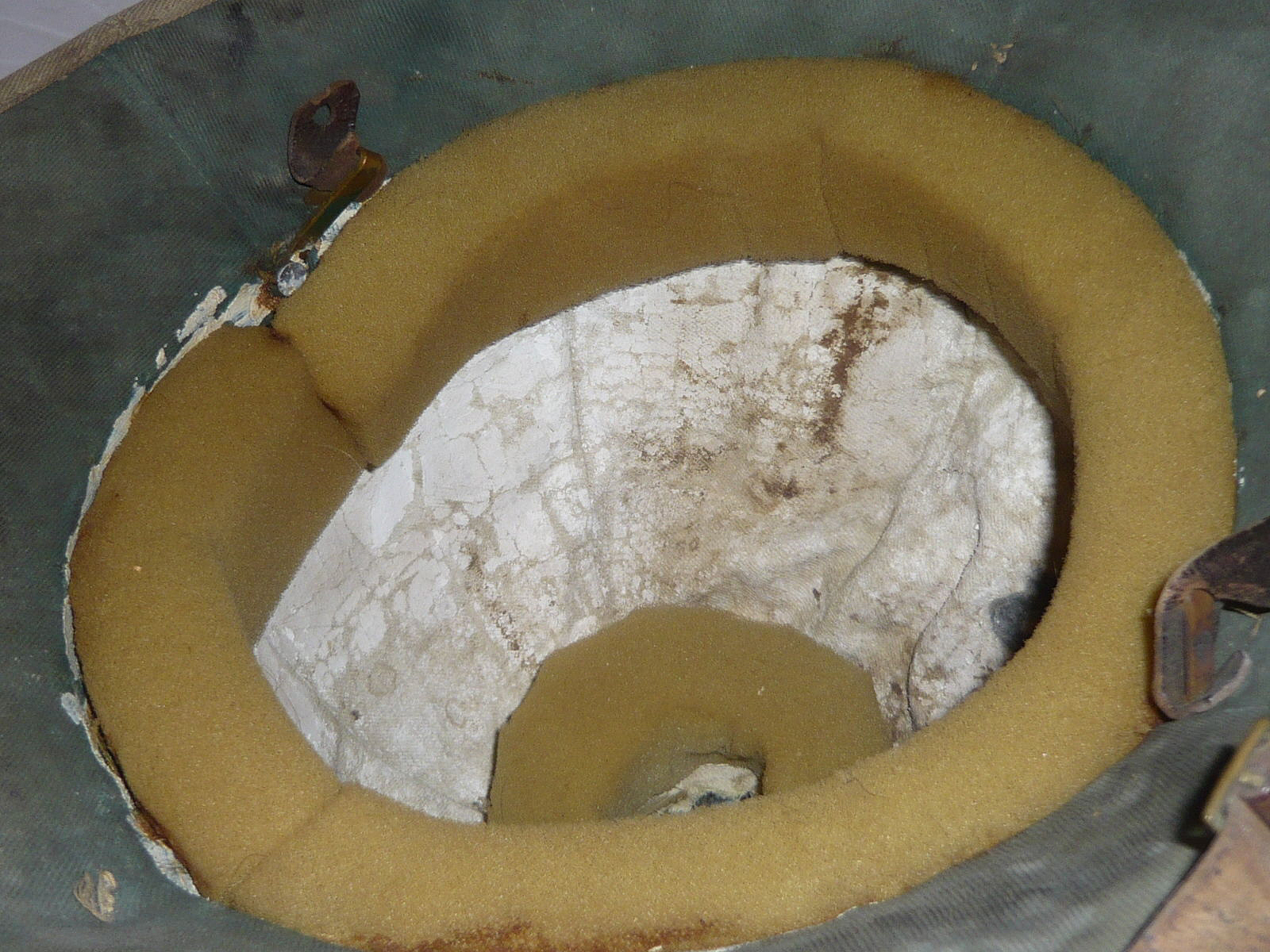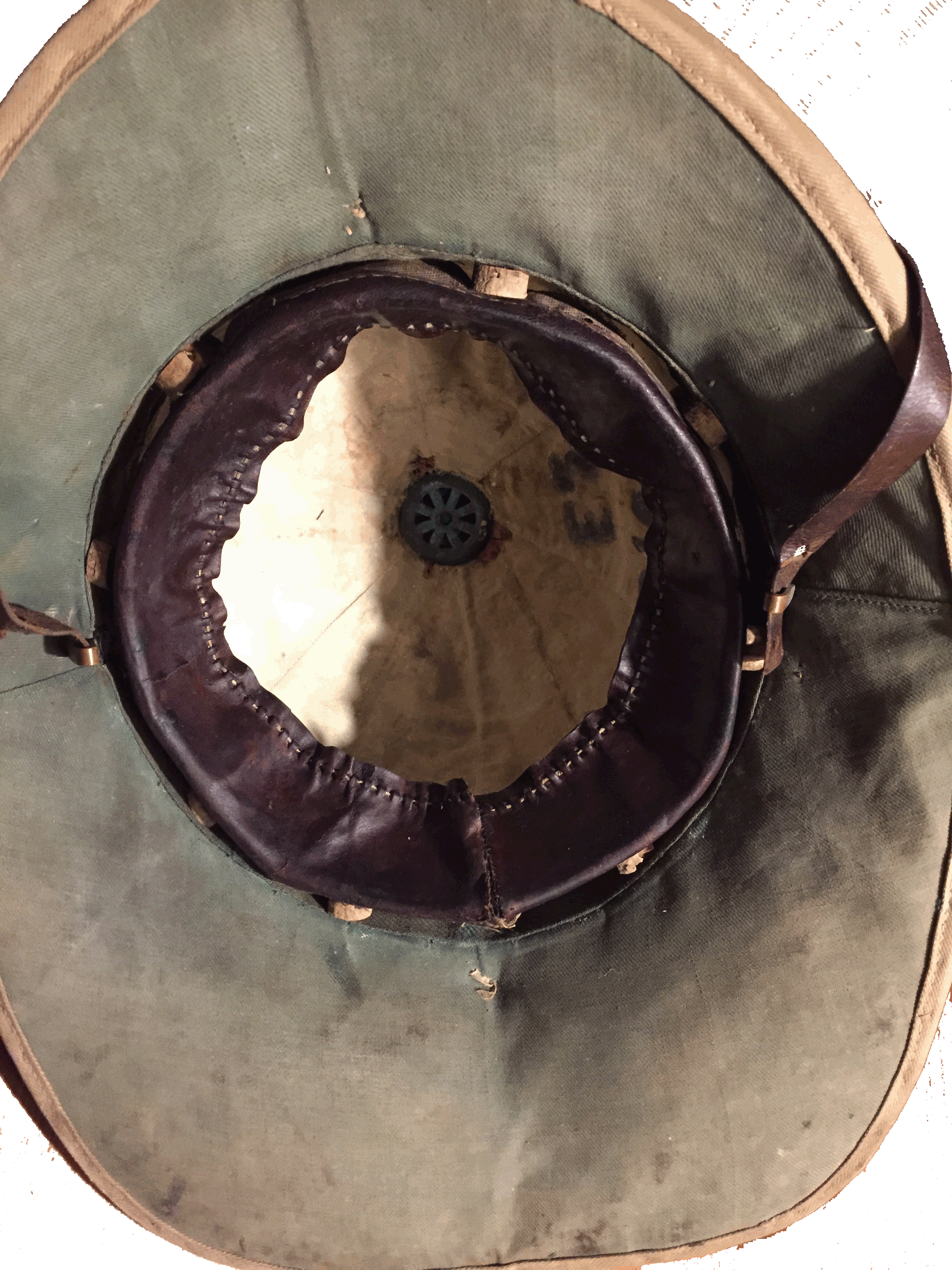The helmet described in this article had been on offer on a certain internet auction platform at the UK for at least two years, headlined as “Vintage Pith Helmet World War 1 WW1 British Army First Please see photo” – The seller´s hint to see the photo first made sense: Many collectors probably have clicked to open the page and closed it immediately after having seen a helmet, filled with yellow foam – besides being offered at a price that was anything but a bargain.
Reopening the page again, in May of this year, the author had a closer look to check, if that helmet could not be an object for restoration? Because, apart from some little spots and a bit of metal being visible on the very top of the ventilation cap, the exterior looked fine – even quite attractive, as the interwar or even indeed WW1 style multifold puggaree was still as it should be: astonishing for an item that obviously had had a hard life. Maybe not in action but certainly in the Palestine and Egypt theaters.
Writing to the seller, explaining the issue, a price that reflected the state as a mending project was agreed. The helmet arrived and close inspection started.
Restoration
First of all, the foam was cut off carefully with a sharp knife. That was not entirely possible. Where the foam had mixed with the glue used, small but ugly spots of it remained, around the former headband and on top, around the ventilation. Somehow, the inner, the white layer of fabric was but not fixed under the ventilation anymore and could be moved outside like a bag. This bag was painted with some sort of cream color – Blanco maybe, but why should the interior be blancoed, anyway?
The Headband
Still, there remained the ugly area of glue (and white paint) where the foam had replaced the former headband. Some years ago, on the same internet auction platform, but in Germany, the crumbled and, worse than that, mouldy remains of an, as well, interwar or even earlier Wolseley had been purchased. The reason was to keep its leather headband, which was very dry, but still complete with all eight cork pieces. That came very handy. From under the brim of a second wreck, strips of strongly faded green fabric were extracted, folded and glued together, to avoid that the edges would ream. Then they were fixed, again, with bookbinder´s glue, with the folded end to the bottom, exactly to cover the areas of paint and glue and the cut above it. Finally, the headband, after having been treated with leather conditioner (repeatedly, as this thing was very dry) was added. The sizes of the helmet and the headband matched exactly. It was fixed just with a small drop of instant adhesive on each piece of cork.
The inner fabric
Carefully, the inner fabric was brushed and massaged in the hands. During that process, the helmet was held against the sun repeatedly to find any remains of a stamp, giving information about the maker and date of issue. There was definitely none. But the glue on top crumbled off without remains, as did the cream color. During that activity, the service number, until then completely unknown, became clearly legible: E.S. 6141802. More about that later. Then, the inner fabric was fixed again connecting it to the cork shell with some spots of bookbinder´s glue up to the top and around the ventilation.
Last details
Finally, three details remained. Firstly, the ventilation cap was flattened. Interesting how that could have happened without crashing the cork shell, but probably happened when the cap was not on the helmet. Anyway, it was carefully bent back into its original shape. Secondly was the original chin strap, amazingly, it was still there, though in two pieces. Again, leather conditioner smoothed it, and bookbinder´s glue joined the two pieces. Thirdly, there were some spots of wax on the upper side. Anyway, an old housewife´s trick was applied. Put a sheet of blotting paper on the wax and suck the wax into it by carefully flattening the paper with a hot flattening iron. Perfect.
Perfect. That is the right word. The ugly duckling finally became a swan.
How to recognize fakes?
Though the old headband dates without doubt from the same period as does the helmet, fixing it is a classic example of what collectors would call a ”marriage”. The author does not mind, there is no intent to fraud – none of his helmets will ever come to the market.
But on the market, many items altered in one way or another, can be seen. These alterations are often described as “field repairs”. Which can make sense. Cork or pith helmets were comparatively delicate things. Most likely even, they were more or less one-way articles – probably thrown away when replacement were easily at hand. Only if not, they might have been repaired. Like this one – perfect on the first and even second view – but with details, that tell differently. These may be of interest to the readers of this website.
Cork spacers
The cork spacers were usually sewn to the helmet. They show at least two holes, matching to holes in the shell of the helmet. The thread went outside and back again. That was usually done when the outer shell was – on its inside and outside – already lined with fabric. The tread then was concealed by the hatband whose job it was to cover such items. As well, inside, the thread went around the strap of fabric, cork or fabric-covered cardboard, or whatever material formed the base to what the leather part of the liner is sewn. Conclusion: whenever glue shows in connection with the cork spacers, there must be doubts.
The hooks
Deliberately, a small detail was not mentioned. The original hooks are still present. During production, they were added before the cork spacers. Again, there is a hole in the cork. On the inside, there is the hook. On the outside, there is a rivet. Quite a large one; again concealed by whatever cloth as added later. Oval holes had to be cut into the strips of bleached cloth. There was no other way; the large rivet cannot be removed. Conclusion: Anything that is not between the hook and the rivet, but around it, is a later addition – “field repair” or fake, but should provoke questions.
Historical authenticity
There is a second question: shall a helmet be altered at all? Deliberately? Imagine, if it is later found out that this very helmet was worn by a VC recipient and any museum would be lucky to have it but would have liked it as it was – with bullet holes if there were any? Well, the author feels excused. Though the foam went into the bin, anything that was added can easily be removed again. For indeed, as the headline indicates – if not that of a VC winner – the former duckling even got a name!
6141802, Ernest Albert Franklin, The East Surrey Regiment
Entering “6141802” and “regiment” or “regimental” at a certain, well-known search engine, there was no success. When tried only two weeks later, the identification disk of this very helmet´s wearer had been sold three days before on the same internet auction platform mentioned above. By another seller – so both things must have gone different ways. Once having a name, everything was easy. Besides, there was luck, for on a private website, dedicated to the family ancestry, the life of 6141802, Ernest Albert Franklin, East Surrey Regiment, was described in detail, including pictures. How often does one get so much information on any officer? Not to speak of an ORs soldier?
http://members.madasafish.com/~cj_whitehound/family/children_of_William_and_Caroline_Franklin.htm
Here follows an extract of the information given on the website: born 1893 in Gibraltar, E.A. Franklin enlisted 1st Battalion The East Surrey Regiment 1908, aged fourteen and 7 months(!), went to France in August 1914, became a POW in May 1917 and remained so until December 1918.
The next extract could give evidence of the helmet´s age, thus dating from the 1920s: “On 15th September 1920 he (E.A. Franklin) married Ada Thirza Hinkley at Mitcham in Surrey. Ada had been in charge (presumably before her marriage, not after) of accommodation for bachelors working in Hong Kong. The couple had two sons: Stanley William George Franklin who was born on 30th November 1927 in Rawalpindi, India and Brian Charles Franklin.”
Franklin remained in 1st Battalion until 1922, the 1st Battalion served overseas 1921-1938, then spent ten years in 2nd Battalion and rose to be Company Quartermaster Sergeant, finally being discharged in 1932. He became a postman and in 1961 a pensioner at the Royal Hospital in Chelsea, London. There, he died in 1970. In November of this year, the regimental newsletter of the East Surreys published this obituary:
“With the passing of “George” Franklin the Regiment loses the last member of a well-known Regimental family. His father, Colour Sergeant William Franklin enlisted in the Thirty First Regiment in 1863 and served until 1884. Ernest Albert Franklin, or George as he was known, was one of three brothers who served in The East Surrey Regiment, one of whom, F.T. Franklin, was killed in action with the Regiment in 1918. George who was born in Gibraltar in 1893, enlisted as a boy at the age of 14 1/2. He went to France with the 1st Surreys in August, 1914, and remained for 14 years with the same battalion. He was a CQMS in the 2nd Bn The East Surrey Regiment when he took his discharge in 1932 after 24 years service. He was admitted to the Royal Hospital, Chelsea in 1961 and finished his days in the company of other old soldiers who had served their country well.”




Saw this on eBay a few times, and thought what a mess someone had made of it. Good job at restoring it to it’s original condition.
I want to thank collector Roland warmly for his kind words and your appreciation of my volume I CASCHI COLONIALI ITALIANI 1889-1943
A so enthusiastic little appreciation expressed by a collector of high level as he certainly can not that proudly here me.
The compliments expressed by a saying the works cannot be among the most appreciated by the author after 3 years of work to realize the volume.
Thank you very much Roland.
Best regards
Enzo Faraone
civicodiciotto@libero.it